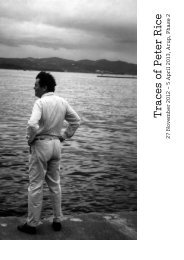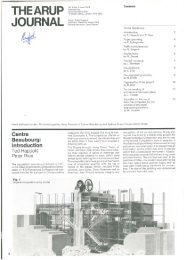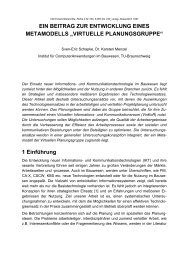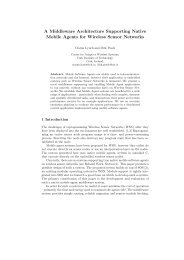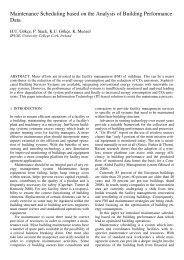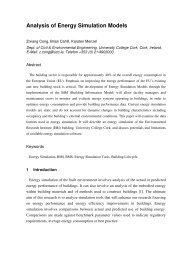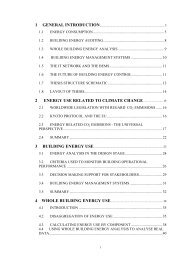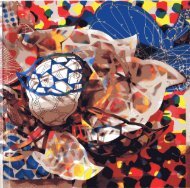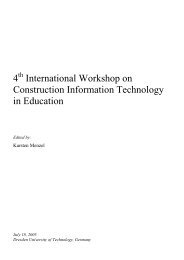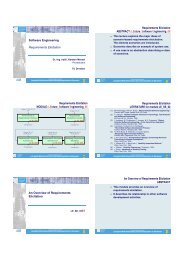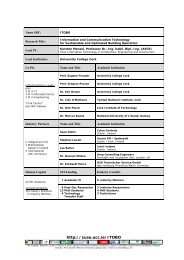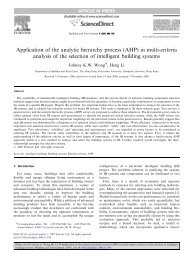Model-based virtual sensors for room heat metering and energy ...
Model-based virtual sensors for room heat metering and energy ...
Model-based virtual sensors for room heat metering and energy ...
You also want an ePaper? Increase the reach of your titles
YUMPU automatically turns print PDFs into web optimized ePapers that Google loves.
5 ConclusionThe introduced approach provides a simple <strong>and</strong> scalable way to estimate the <strong>heat</strong>ing <strong>energy</strong> of <strong>room</strong>sfrom simple temperature readings <strong>and</strong> a central <strong>heat</strong> meter. The approach can basically be applied toany buildings <strong>heat</strong>ing system that <strong>room</strong>s are individually controlled, as long as a representative staticor dynamic relative <strong>heat</strong>ing coefficient can be defined. Using this coefficient <strong>and</strong> remodelling thecontrol behaviour minimises the needed sensor equipment. As wireless temperature <strong>sensors</strong> providenowadays a cheap <strong>and</strong> easy integration in any building (Menzel, K. et al., 2008), the approach haspractical value <strong>for</strong> per<strong>for</strong>mance analysis of existing buildings. The approach can be used both <strong>for</strong>offline data analysis <strong>and</strong> online as a <strong>virtual</strong> sensor to meter <strong>room</strong>s’ <strong>heat</strong> flow.The investigated case study of the ERI building showed that the approach permits to identify<strong>energy</strong> problems in a building. The analysis covered also aspects of the renewable <strong>energy</strong> sourcesutilised by the ERI building. The combination with an approach to estimate the thermal com<strong>for</strong>t in the<strong>room</strong>s (Ahmed, A. et al., 2009) further complements the basis <strong>for</strong> decision making to improve thebuildings <strong>energy</strong> consumption. Both approaches mainly utilise simple temperature <strong>sensors</strong> <strong>and</strong>,there<strong>for</strong>e, provide simple ways to evaluate buildings system efficiency <strong>and</strong> <strong>room</strong>s’ consumption whilereducing the building monitoring cost.AcknowledgementsWork in the Strategic Research Cluster ‘ITOBO’ is funded by grant 06-SRC-I1091 from ScienceFoundation Irel<strong>and</strong> (SFI) with additional contributions from five industry partners. Joern Ploennigsthanks the Humboldt-Foundation <strong>and</strong> the German BMBF <strong>for</strong> supporting his research in Irel<strong>and</strong>.ReferencesAHMED, A., J. PLOENNIGS, Y. GAO, <strong>and</strong> K. MENZEL. 2009. Analyse building per<strong>for</strong>mance data <strong>for</strong> <strong>energy</strong>-efficientbuilding operation. In: CIB W78 - 26th Int. Conf. on Managing IT in Construction. Istanbul, Turkey.AUGENBROE, G. <strong>and</strong> C.-S. PARK. 2005. Quantification methods of technical building per<strong>for</strong>mance. Building Research<strong>and</strong> In<strong>for</strong>mation. 33(2), pp.159-172.CHIRAS, D. 2006. The homeowner's guide to renewable <strong>energy</strong>: achieving <strong>energy</strong> independence through solar, wind,biomass <strong>and</strong> hydropower. New Society Publishers.CHWIEDUK, D. 2003. Towards sustainable-<strong>energy</strong> buildings. Applied Energy. 76(1-3), pp.211-217.CLARIDGE, D., J. HABERL, M. LIU et al. 1994. Can You Achieve 150 Percent Predicted Retrofit Savings: Is It Time <strong>for</strong>Recommissioning? In: ACEEE 1994 Summer Study on Energy Efficiency in Buildings. Washington D.C., US, pp.73-88.ISO 7730 - Ergonomics of the thermal environment - Analytical determination <strong>and</strong> interpretation of thermal com<strong>for</strong>t usingcalculation of the PMV <strong>and</strong> PPD indices <strong>and</strong> local thermal com<strong>for</strong>t criteria. 2005. ISO.ITOBO. 2007. In<strong>for</strong>mation & Communication Technology <strong>for</strong> Sustainable <strong>and</strong> Optimised Building Operation. Cork:http://zuse.ucc.ie/itobo/.JAGEMAR, L. <strong>and</strong> D. OLSSON. 2007. The EPBD <strong>and</strong> Continuous Commissioning.KEANE, M. 2005. Hidden Depths. Building Service Journal., pp.23-28.MENZEL, K., D. PESCH, B. O’FLYNN et al. 2008. Towards a Wireless Sensor Plat<strong>for</strong>m <strong>for</strong> Energy Efficient BuildingOperation. In: 12th Int. Conf. on Computing in Civil <strong>and</strong> Building Engineering. Beijing, China, pp.381-386.NGOWI, A. B. 2001. Creating competitive advantage by using environment-friendly building processes. Building <strong>and</strong>Environment. 36(3), pp.291-298.ROULET, C.A. <strong>and</strong> B. ANDERSON. 2006. CEN St<strong>and</strong>ards <strong>for</strong> Implementing the European Directive on EnergyPer<strong>for</strong>mance of Buildings. In: PLEA - 23rd Int. Conf. on Passive <strong>and</strong> Low Energy Architecture. Geneva, Switzerl<strong>and</strong>.VASYUTYNSKYY, V., J. PLOENNIGS, <strong>and</strong> K. KABITZSCH. 2005. Passive Monitoring of Control Loops in BuildingAutomation. In: FET 2005 - 6th IFAC Int. Conf. on Fieldbus Systems <strong>and</strong> their Applications. Mexico, pp.263-269.WOLFGANG, F. 2005. Assessing building per<strong>for</strong>mance. Butterworth-Heinemann.



